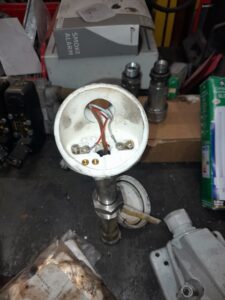Maintaining the right temperature is often the key to ensuring the smooth operation of various manufacturing systems. When a manufacturing plant recently faced temperature-related challenges, they called Hale Engineering to investigate and resolve the issue. What they discovered was a difference in temperature probes that if changed would lead to a significant upgrade and improved efficiency in their operations.
The Challenge: Mismatched Temperature Probes
The manufacturing plant had been using temperature probes for years to monitor and control critical temperature parameters in their processes. However, they were encountering inconsistencies and inaccuracies in their temperature readings. Something needed to be done to rectify the situation and prevent potential production setbacks.
Upon closer inspection, our engineer quickly identified the root cause of the problem. The plant had recently acquired new Temperature Probes, which were of the 3-wire PT100 type. However, the existing temperature probes in use were 2-wire RTDs (Resistance Temperature Detectors). This disparity in probe types was causing discrepancies in temperature readings, leading to operational inefficiencies.
The Solution: Upgrading and Integration
Our engineer knew that a transition from the old probes to the new ones was essential. The first step in the solution was to ensure the proper connection of the new cabling. This involved making necessary connections and configuring the Programmable Logic Controller (PLC).
Additionally, the engineer replaced the old Temperature Probes with the new ones. To ensure flawless functionality, the engineer ran new cables to all four new probes, allowing them to operate correctly. These new probes were also connected to the PLC, ensuring a reliable data transfer process.
Furthermore, the engineer took on the task of configuring the probes within the PLC program. This step was critical to ensure that the temperature readings from the new probes were accurate and consistent. Once the configuration was complete, it was time to put the upgraded system to the test.
Thorough Testing and Validation
Rigorous testing was essential to validate the effectiveness of the upgrades. Our engineer tested the plant’s performance, monitoring temperature parameters at various critical points. This comprehensive testing process allowed them to identify any remaining discrepancies or issues and make the necessary adjustments.
Conclusion: A Successful Upgrade for Enhanced Efficiency
In this case study, we saw how a seemingly simple difference in temperature probes had the potential to disrupt manufacturing processes. However, with the expertise of an experienced engineer, the plant was able to seamlessly upgrade its temperature monitoring system. The transition from 2-wire RTDs to 3-wire PT100 probes not only resolved the issue but also improved overall efficiency.
This case study highlights the importance of precision in industrial processes and the value of having skilled professionals who can identify and address such discrepancies. By investing in the right equipment and expertise, manufacturing plants can optimise their operations, reduce downtime, and ultimately achieve higher levels of productivity.

